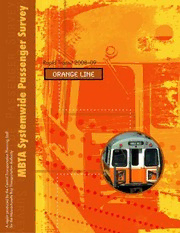
Orange Line 2008–09 MBTA Systemwide Passenger Survey Report PDF
Preview Orange Line 2008–09 MBTA Systemwide Passenger Survey Report
M y B y e Te v v A rr u u S S S r y e s g r tn e Rapid Transit 2008–09 e e gs m s Orange Line n a w eP i s e d s d e ai w P Pm a e e st f daf s St sy g in i S n e n wa Ply A n ritn moo ih T atutg rtA B eo pn soe ni M taat rt Torr alp srs ntan e yCTr he ay S Sy ts B bettu edus ch ucr da Aos rs pav M Trt oe phe BA reor t fy M MBTA Systemwide Passenger Survey RAPID TRANSIT 2008–09 Orange Line Prepared for MBTA Planning and Development Joseph M. Cosgrove, Director Project Manager Thomas J. Humphrey Project Principal Elizabeth M. Moore Primary Authors Thomas J. Humphrey Steven P. Andrews Data Analysts Thomas J. Humphrey Steven P. Andrews Mariya A. Maslova Mary McShane Graphics Ken Dumas Cover Design Kim Noonan The preparation of this document was supported by the Federal Transit Administration through MBTA contract #X94PS25. Central Transportation Planning Staff Directed by the Boston Region Metropolitan Planning Organization. The MPO is composed of state and regional agencies and authorities, and local governments. June 2010 ABSTRACT This Orange Line report belongs to a multivolume set of reports on the findings of a systemwide survey of Massachusetts Bay Transportation Authority riders that was conducted for the MBTA by the Central Transportation Planning Staff (CTPS) in 2008–09. This survey covers all of the modes operated by the MBTA: bus (including trackless trolley), bus rapid transit,1 heavy rail (the Blue, Red, and Orange Lines), light rail (the Green Line and the Mattapan High-Speed Line), commuter rail, and boat. The most recent comparable systemwide passenger survey was conducted during 1993–2000. The purpose of the systemwide survey was to gather data that are not easily obtained through any other means. The data are used to update the regional travel-demand model that is routinely used by the Boston Region Metropolitan Planning Organization (MPO); they are also available for use by other entities, public and private, as well as interested individuals. This report comprises 14 chapters and three appendices. In the chapters, data tables and summary text present information about Orange Line travel, including why trips are made, where riders are coming from and going to, how riders get to and from the service, and the stations at which they enter and exit the rapid transit system. Information is also provided on the demographics of Orange Line riders, as well as their automobile ownership, how they pay their fares, and how they perceive the quality of MBTA rapid transit service. The second chapter of this report provides an overview of the results for the entire Orange Line, while each subsequent chapter covers one or more types of data on a station-by-station basis. 1 Reports on bus rapid transit (the Silver Line) are included in the set, although their data are from surveys conducted by CTPS in 2005 and 2006. CTPS iii CONTENTS List of Exhibits viii 1 INTRODUCTION 1-1 1.1 The Systemwide Survey 1-1 1.2 Orange Line Survey Method 1-1 1.3 Organization of Data in This Report 1-2 2 RESULTS FOR THE ORANGE LINE AS A WHOLE 2-1 2.1 Trip Purpose, Reasons for Using the MBTA, and Alternative Means 2-1 2.2 Origin Locations and Activities 2-2 2.3 Access to the Rapid Transit System 2-2 2.4 Exits from the Rapid Transit System 2-3 2.5 Entries to the Rapid Transit System 2-3 2.6 Egress from the Rapid Transit System 2-4 2.7 Destination Locations and Activities 2-4 2.8 Origin-Destination Cross-tabulation 2-5 2.9 Socioeconomic Characteristics 2-5 2.10 Usage Rates and Fare Types 2-6 2.11 Vehicle Availability 2-6 2.12 Service Quality 2-6 2.13 Comments and Suggestions 2-7 3 TRIP PURPOSE, REASONS FOR USING THE MBTA, AND ALTERNATIVE MEANS 3-1 3.1 Trip Purpose 3-1 3.2 Reasons for Using the MBTA 3-3 3.3 Alternative Means of Transportation 3-5 CTPS v MBTA SYSTEMWIDE PASSENGER SURVEY: ORANGE LINE 4 ORIGIN LOCATIONS AND ACTIVITIES 4-1 4.1 Origin Locations 4-1 4.2 Origin Activities 4-2 5 ACCESS TO THE RAPID TRANSIT SYSTEM 5-1 5.1 Access Mode 5-1 5.2 Trip Time for Access via Private Transportation 5-3 5.3 Transfers to the Orange Line from Commuter Rail, Bus, or Boat 5-4 6 EXITS FROM THE RAPID TRANSIT SYSTEM 6-1 6.1 Description of Tables 6-1 6.2 Overview of Results 6-3 7 ENTRIES TO THE RAPID TRANSIT SYSTEM 7-1 7.1 Description of Tables 7-1 7.2 Overview of Results 7-3 8 EGRESS FROM THE RAPID TRANSIT SYSTEM 8-1 8.1 Egress Mode 8-1 8.2 Trip Time for Egress via Private Transportation 8-3 8.3 Transfers from the Orange Line from Commuter Rail, Bus, or Boat 8-3 9 DESTINATION LOCATIONS AND ACTIVITIES 9-1 9.1 Destination Locations 9-1 9.2 Destination Activities 9-3 10 ORIGIN-DESTINATION CROSS-TABULATION 10-1 10.1 Description of Table 10-1 10.2 Overview of Results 10-2 11 SOCIOECONOMIC CHARACTERISTICS 11-1 11.1 Age of Riders 11-1 11.2 Gender of Riders 11-2 11.3 Annual Household Income 11-3 11.4 Ethnicity of Riders 11-4 12 USAGE RATES AND FARE TYPES 12-1 12.1 Number of Days Used per Week 12-1 12.2 Weekend Usage 12-2 12.3 Fare Types and Pass Usage 12-3 vi CTPS TABLE OF CONTENTS 13 VEHICLE AVAILABILITY 13-1 13.1 Licensed Drivers 13-1 13.2 Usable Vehicles per Household 13-2 13.3 Riders with a Household Vehicle Available for the Trip 13-3 13.4 Vehicles Owned per Capita 13-4 14 SERVICE QUALITY 14-1 14.1 Description of Table 14-2 14.2 Overview of Results 14-2 APPENDIX A: SURVEY DISTRIBUTION, RESPONSE, PROCESSING, AND EXPANSION APPENDIX B: TRANSFER STATION RESULTS FOR ALL RIDERS REGARDLESS OF LINE APPENDIX C: SURVEY FORM CTPS vii EXHIBITS Figure 4-1 Neighborhood Boundaries 4-5 Table 5-1 Designations Used for Private and Other Non-MBTA Bus Services 5-4 A-1 2008-2009 Survey Distribution and Response by Mode A-4 KEYWORDS systemwide survey rapid transit system Orange Line MBTA viii CTPS
